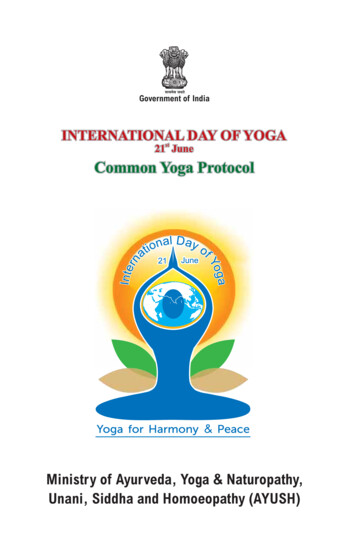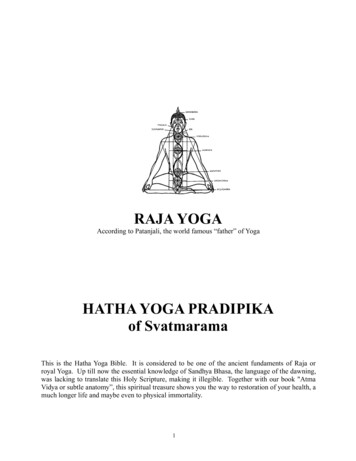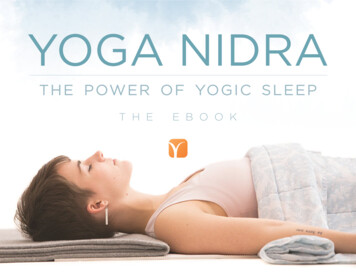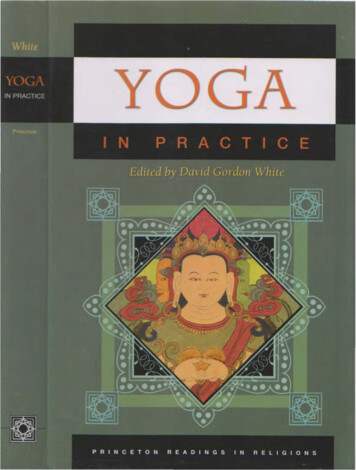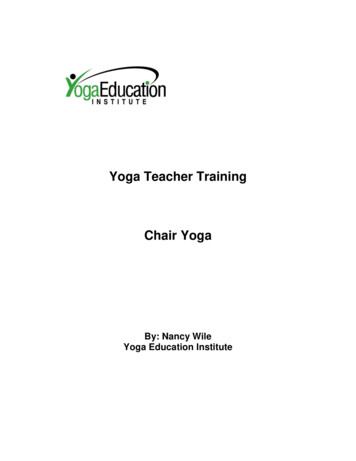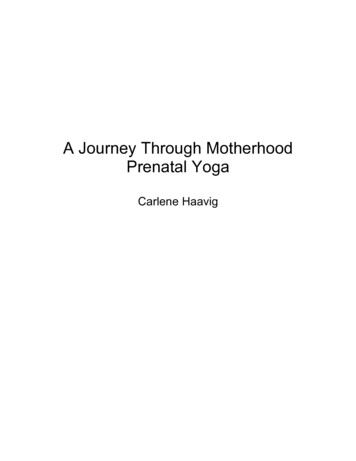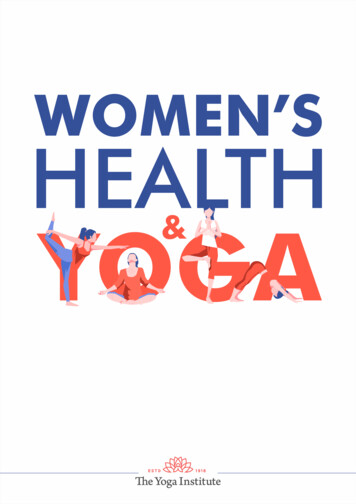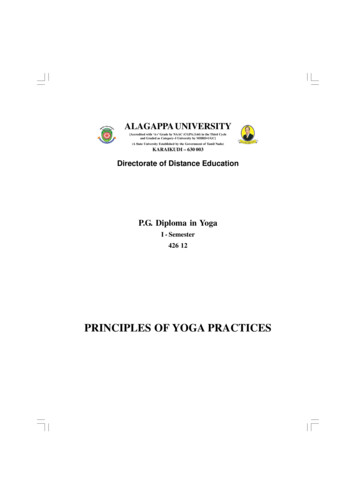
Transcription
ALAGAPPA UNIVERSITY[Accredited with ‘A ’ Grade by NAAC (CGPA:3.64) in the Third Cycleand Graded as Category–I University by MHRD-UGC](A State University Established by the Government of Tamil Nadu)KARAIKUDI – 630 003Directorate of Distance EducationP.G. Diploma in YogaI - Semester426 12PRINCIPLES OF YOGA PRACTICES
ReviewerDr K. BalasubramanianProfessor and Head,Department of Physical Education,Alagappa University,KaraikudiAuthorNeeru Sood, Freelance AuthorUnits (1-14)"The copyright shall be vested with Alagappa University"All rights reserved. No part of this publication which is material protected by this copyright noticemay be reproduced or transmitted or utilized or stored in any form or by any means now known orhereinafter invented, electronic, digital or mechanical, including photocopying, scanning, recordingor by any information storage or retrieval system, without prior written permission from the AlagappaUniversity, Karaikudi, Tamil Nadu.Information contained in this book has been published by VIKAS Publishing House Pvt. Ltd. and hasbeen obtained by its Authors from sources believed to be reliable and are correct to the best of theirknowledge. However, the Alagappa University, Publisher and its Authors shall in no event be liable forany errors, omissions or damages arising out of use of this information and specifically disclaim anyimplied warranties or merchantability or fitness for any particular use.Vikas is the registered trademark of Vikas Publishing House Pvt. Ltd.VIKAS PUBLISHING HOUSE PVT. LTD.E-28, Sector-8, Noida - 201301 (UP)Phone: 0120-4078900 Fax: 0120-4078999Regd. Office: 7361, Ravindra Mansion, Ram Nagar, New Delhi 110 055 Website: www.vikaspublishing.com Email: helpline@vikaspublishing.comWork Order No. AU/DDE/DE1-484/Printing of Course Materials/2019 Dated 08.07.2019 Copies-500
SYLLABI-BOOK MAPPING TABLEPrinciples of Yoga PracticesBLOCK 1: Application of YogaUNIT – I: Basic Principles of yoga – Proper Relaxation – Proper Exercise– Proper Breathing – Proper Diet – Positive Thinking and Meditation.UNIT – II: Definitions of Physical Education – Application of in PhysicalEducation – Yoga – Physical Education – Application of Various Systemsof Yoga – Application of Karma Yoga – Application of Bhakhi Yoga –Application of Jnana Yoga – Application of Hatha Yoga – Applicationof Mantra Yoga – Application of Yantra Yoga – Application of Laya andKundalini Yoga – Application of Tantra Yoga – Application of RajaYoga/Ashtanga Yoga – Application of Yama – Application of Niyama –Application of Asana – Application of Pranayama – Application ofPratyahara – Application of Dharana – Application of Dhyana –Application of Samadhi.UNIT – III: Importance of Yoga in Physical Education – Astanga Yogaand Importance – Importance of Yama – Importance of Niyama –Importance of Asana – Importance of Pranayama – Importance ofPratyahara – Importance of Dharana – Importance of Dhyana –Importance of Samadhi.UNIT – IV: Importance of Yoga in Various Sports – Importance of Yogafor Athletes – Running – Importance of Yoga for Athletes-Jumping –Importance of Yoga for Athletes – Throwing – Importance of yoga forArchery – Importance of yoga for Boxing – Importance of yoga forWrestling – Importance of yoga for Gymnastics – Importance of yogafor weight lifting – Importance of Yoga for Football – Importance ofYoga for Hockey – Importance yoga for Tennis.BLOCK 2: General Methods of YogaUNIT-V: General Importance of yoga in Physical Education & Sports –Physical Benefits of yoga – Physiological benefits of yoga – Biochemicalbenefits of Yoga – Psychological benefits of Yoga – Other benefits ofYoga.UNIT – VI: Differences between Yogasanas and Physical Exercises –Locomotors system – Nervous system – Circulation – Heart – Lungs –Gastro-Intestinal Track – Renal – Endocrine.UNIT – VII: Methods of Teaching Yogic Techniques – Introduction –Demonstration – Practicing the Asana/Practice – Relaxation and ClosingUNIT – VIII: Preparatory movements – Breathing practice – Hands inand out breathing – Hands-stretch breathing – Ankle-stretch breathing– Stretching Practices (Loosening Exercise) – Mukha Dhouti (CleaningThrough a single Blast Breath) – Front and back bending of Waist –Side bending and Twisting of Waist – Twist with bending – PhysicalActivity – Adherence to Exercise – Systems of Physical Exercise.Unit 1: Basic Principles of Yoga(Pages 1-10)Unit 2: Yoga and Its Application(Pages 11-22)Unit 3: Importance of Yoga inPhysical Education(Pages 23-42)Unit 4: Importance of Yoga inVarious Sports(Pages 43-54)Unit 5: Yoga and Its Benefits(Pages 55-60)Unit 6: Differences Between Yogasanasand Physical Exercises(Paoges 61-69)Unit 7: Methods of TeachingYogic Techniques(Pages 70-74)Unit 8: Preparatory Movements(Pages 75-86)
BLOCK 3: Types of Asanas and PranayamaUNIT – IX: The Surya Namaskar – The solar Tradition – Salute to thesun – Effects of Surya Namaskar – Reapiratory system – Circulatorysystem – Digestive system – Skin – Nervous system – The Endocrinesystem – Pituitary gland – Pineal Gland – Pancreas.UNIT – X: Asanas – Introduction – Objectives of Asanas – CommonAsanas – Classification of Asanas – Classification on the basis ofStarting Position – Standing Asanas – Sitting Asanas – Prone Asanas– Supine Asanas – Meditation Asanas – Relaxation Asanas – CulturalAsanas – Backward bending Asanas – Forward bending Asanas –Spinal Twisting Asanas – Inverted Asanas – Balacing Asanas.UNIT – XI: Pranayama – Prana and lifestyle – Breathe, health andPranayama – Breathing and life span – Pranayama and the spiritualaspirant – Types of Pranayama – Sensitizing Pranayama – TranquilizingPranayama – Vitalizing PranayamBLOCK 4: Methods of MeditationUNIT – XII: Balancing Pranayama – Mudras – Mudras and Prana –Scientific benefits of Mudras – Hasta (Hand mudras) – Mana (Headmudra) – Kaya (postural mudra ) – Bandha (Lock mudra) – Adhara(perineal mudra) – Bandhas – Concept of lock – Mechanics of Bandhas– Moola bandha (perineal contraction) – Uddiyana bandha (abdominalcontraction) – Jalandhara bandha (throat compression) – Physical effectsof bandhasUNIT – XIII: Kriyas – Introduction – Kapalabhati – Trataka – Neti – Jalneti – Sutra neti – Dhouti – Vamana dhouti – Nauli – Basti.UNIT – XIV: Meditation – Methods of meditation – Concept ofMeditation – Specific technique – Muscle relaxation – Logic relaxation– Self-induced state – Self-focus skill – Benefits of meditation – SriAurobindo meditation – Centres of Concentration – Vethathri Maharishimeditation – Vallalar meditation – Vipasana meditation – Tamil siddhameditation – Transcendental meditation.Unit 9: The Surya Namaskar(Pages 87-94)Unit 10: Asanas(Pages 95-109)Unit 11: Pranayama(Pages 110-117)Unit 12: Balancing Pranayama(Pages 118-126)Unit 13: Kriyas(Pages 127-131)Unit 14: Meditation(Pages 132-145)
CONTENTSINTRODUCTIONBLOCK I: APPLICATION OF YOGAUNIT 1BASIC PRINCIPLES OF YOGA1-101.0 Introduction1.1 Objectives1.2 Basic Principles of Yoga: An .7Proper Relaxation in YogaProper ExerciseProper BreathingProper DietPositive Thinking and MeditationAnswers to Check Your Progress QuestionsSummaryKey WordsSelf Assessment Questions and ExercisesFurther ReadingsUNIT 2YOGA AND ITS APPLICATION2.0 Introduction2.1 Objectives2.2 Physical Education2.2.1 Definitions of Physical Education2.2.2 Application of Yoga in Physical Education2.3 Application of Various Systems of pplication of Karma Yoga (Self-less Work for Our Fellow Neighbour)Application of Bhakti Yoga (Union through Love and Devotion)Application of Jnana YogaApplication of Hatha YogaApplication of Mantra YogaApplication of Yantra YogaApplication of Laya and Kundalini YogaApplication of Tantra YogaApplication of Raja Yoga/Radja Yoga2.4 Yoga/Ashtanga 82.9Application of Yama and NiyamaApplication of AsanaApplication of PranayamaApplication of PratyaharaApplication of DharanaApplication of DhyanaApplication of SamadhiAnswers to Check Your Progress QuestionsSummaryKey WordsSelf Assessment Questions and ExercisesFurther Readings11-22
UNIT 43.1523-42IntroductionObjectivesYoga and Physical EducationAshtanga Yoga and Its ImportanceThe Importance of YamaThe Importance of NiyamaThe Importance of AsanaThe Importance of PranayamaThe Importance of PratyaharaThe Importance of DharanaThe Importance of Dhyana and SamadhiAnswers to Check Your Progress QuestionsSummaryKey WordsSelf Assessment Questions and ExercisesFurther ReadingsUNIT 44.04.14.24.3IMPORTANCE OF YOGA IN PHYSICAL EDUCATIONIMPORTANCE OF YOGA IN VARIOUS SPORTS43-54IntroductionObjectivesImportance of Yoga in Various Sports: An IntroductionImportance of Yoga for Athletes4.3.1 In Running4.3.2 In Jumping4.3.3 In Throwing4.4 Importance of Yoga for Different .64.74.84.9Importance of Yoga for ArcheryImportance of Yoga for BoxingImportance of Yoga for WrestlingImportance of Yoga for GymnasticsImportance of Yoga for Weight LiftingImportance of Yoga for FootballImportance of Yoga for HockeyImportance of Yoga for TennisAnswers to Check Your Progress QuestionsSummaryKey WordsSelf Assessment Questions and ExercisesFurther ReadingsBLOCK II: GENERAL METHODS OF YOGAUNIT 5YOGA AND ITS BENEFITS5.0 Introduction5.1 Objectives5.2 General Importance of Yoga in Physical Education and Sports5.2.1 Physical Benefits of Yoga5.2.2 Physiological Benefits of Yoga5.2.3 Biochemical Benefits of Yoga55-60
5.2.4 Psychological Benefits of Yoga5.2.5 Other Benefits of Yoga5.35.45.55.65.7Answers to Check Your Progress QuestionsSummaryKey WordsSelf Assessment Questions and ExercisesFurther ReadingsUNIT 6DIFFERENCES BETWEEN YOGASANASAND PHYSICAL as and Physical ExercisesSystems of the 6.66.76.8Locomotors SystemNervous SystemCirculationHeartLungsGastro-Intestinal TractRenalEndocrineAnswers to Check Your Progress QuestionsSummaryKey WordsSelf Assessment Questions and ExercisesFurther ReadingsUNIT 77.07.17.27.361-69METHODS OF TEACHING YOGIC TECHNIQUES70-74IntroductionObjectivesSteps for Teaching YogaProcess of Teaching Yogic Technique7.3.1 Demonstration7.3.2 Practicing the Asanas7.3.3 Relaxation and Closing7.47.57.67.77.8Answers to Check Your Progress QuestionsSummaryKey WordsSelf Assessment Questions and ExercisesFurther ReadingsUNIT 88.08.18.28.3PREPARATORY MOVEMENTSIntroductionObjectivesMeaning of Preparatory MovementsBreathing Practice8.3.1 Hands In and Out Breathing8.3.2 Hands-Stretch Breathing8.3.3 Ankle-Stretch Breathing75-86
8.4 Stretching Practices (Loosening Exercise)8.5 Mukha Dhauti (Cleaning through a Single Blast Breath)8.6 Bending Practice8.6.1 Front and Back Bending of Waist8.6.2 Side Bending and Twisting of Waist8.6.3 Twist with Bending8.7 Physical Activity8.7.1 Adherence to Exercise8.7.2 Systems of Physical Exercise8.88.98.108.118.12Answers to Check Your Progress QuestionsSummaryKey WordsSelf Assessment Questions and ExercisesFurther ReadingsBLOCK III: TYPES OF ASANAS AND PRANAYAMAUNIT 9THE SURYA NAMASKAR87-949.0 Introduction9.1 Objectives9.2 The Concept of Surya Namaskar9.2.1 The Solar Tradition9.2.2 Salute to the Sun9.3 Effects of Surya 3.99.49.59.69.79.8Respiratory SystemCirculatory SystemDigestive SystemSkinNervous SystemEndocrine SystemPituitary GlandPineal GlandPancreasAnswers to Check Your Progress QuestionsSummaryKey WordsSelf Assessment Questions and ExercisesFurther ReadingsUNIT 10ASANAS10.0 Introduction10.1 Objectives10.2 The Concept of Asanas10.2.1 Objective of Asanas10.2.2 Common Asanas10.3 Classification of Asanas10.3.110.3.210.3.310.3.4Classification on the Basis of Starting PositionMeditation AsanasRelaxation AsanasCultural Asanas95-109
Backward Bending AsanasForward Bending AsanasSpinal Twisting AsanasInverted AsanasBalancing AsanasAnswers to Check Your Progress QuestionsSummaryKey WordsSelf Assessment Questions and ExercisesFurther ReadingsUNIT 11PRANAYAMA110-11711.0 Introduction11.1 Objectives11.2 The Concept of Pranayama11.2.111.2.211.2.311.2.4Prana and LifestyleBreathe, Health and PranayamaBreathing and Life SpanPranayama and the Spiritual Aspirant11.3 Types of Pranayama11.3.1 Tranquilizing Pranayama11.3.2 Sensitizing Pranayama11.3.3 Vitalizing Pranayama11.411.511.611.711.8Answers to Check Your Progress QuestionsSummaryKey WordsSelf Assessment Questions and ExercisesFurther ReadingsBLOCK IV: METHODS OF MEDITATIONUNIT 12BALANCING PRANAYAMA12.0 Introduction12.1 Objectives12.2 Mudra12.2.112.2.212.2.312.2.412.2.512.2.6Mudra and PranaScientific Benefits of MudrasHasta MudraMana MudraKaya (Postural) MudraAdhara – Perineal Mudras12.3 Bandha: Lock Mudras12.3.1 Concept of Lock12.3.2 Mechanics of Bandhas12.3.3 Physical Effect of Bandhas12.412.512.612.712.8Answers to Check Your Progress QuestionsSummaryKey WordsSelf Assessment Questions and ExercisesFurther Readings118-126
UNIT 13KRIYAS127-13113.0 Introduction13.1 Objectives13.2 13.513.613.7KapalabhatiTrataka KriyaNeti KriyasDhouti KriyaNauli KriyasVasti KriyasAnswers to Check Your Progress QuestionsSummaryKey WordsSelf Assessment Questions and ExercisesFurther ReadingsUNIT 14MEDITATION14.0 Introduction14.1 Objectives14.2 Introduction to Meditation14.2.1 Methods of Meditation14.2.2 Concept of Meditation14.3 Specific Techniques14.3.1 Muscle Relaxation14.3.2 Logic Relaxation14.3.3 Self-Induced State14.4 Benefits of Meditation14.5 Types of 14.714.814.914.1014.11Sri Aurobindo MeditationVethathiri Maharishi MeditationVallalar MeditationVipasana MeditationTamil Siddha MeditationTranscendental MeditationCenters of Meditation/ConentrationAnswers to Check Your Progress QuestionsSummaryKey WordsSelf Assessment Questions and ExercisesFurther Readings132-145
INTRODUCTIONOne of the most commonly recognized and easily popular forms of exercise thatone can find around themselves in this day and age is Yoga. This unique practice ismeant to harmonize the physical, spiritual and mental practices of the humans.Yoga as a practice has been a part of Indian culture for centuries. In fact, it is acrucial part of the six ancient hindu philosophies. What distinguishes yoga fromother forms of exercises is the fact that it integrates the achievement of spiritualwellbeing alongside the physical wellbeing. The practice of yoga is based on thefoundation of certain principles like breathing, proper exercise, diet, meditationand realisation.NOTESYoga can be integrated in school education by incorporating it as a part ofphysical education. The techniques of teaching yoga are also another field crucialto the practice of yoga. Yoga is beneficial as a preparatory exercise for differentsports. There are many different yoga asanas, and applications of yoga whichmust be learnt so as to make the best out of yoga as an exercise more smoothly.The benefits of yoga are not limited to only physical benefits but also psychologicalbenefits. It is important to learn about the different methods and practices of yoga.This book, Principles of Yoga Practices, is written with the distance learningstudent in mind. It is presented in a user-friendly format using a clear, lucid language.Each unit contains an Introduction and a list of Objectives to prepare the studentfor what to expect in the text. At the end of each unit are a Summary and a list ofKey Words, to aid in recollection of concepts learnt. All units contain SelfAssessment Questions and Exercises, and strategically placed Check Your Progressquestions so the student can keep track of what has been discussed.Self-InstructionalMaterial
BLOCK - IAPPLICATION OF YOGAUNIT 1BASIC PRINCIPLESOF YOGABasic Principles of YogaNOTESStructure1.0 Introduction1.1 Objectives1.2 Basic Principles of Yoga: An .71.0Proper Relaxation in YogaProper ExerciseProper BreathingProper DietPositive Thinking and MeditationAnswers to Check Your Progress QuestionsSummaryKey WordsSelf Assessment Questions and ExercisesFurther ReadingsINTRODUCTIONYoga word comes from the Sanskrit word ‘Yog’ which means union, the unionbetween God and humans. Yoga is the practice where the mind, body and soul,gets involved with the ultimate. Yoga is the practice to eliminate all the negativeforce around the life and to elevate the ‘Kundalini’ (life force) to dissolve the spiritwith the Almighty. When it is on physical ground, we practice ‘Asanas’ or posturesto keep fit. There are breathing techniques or ‘Pranayama’ and meditation or‘Dhyana’ to bring back the serenity and purity of the mind.In India, yoga practice is a part of the culture and tradition. From millions ofyears, the saints and sages have practiced yoga. There are myths and storiesabout yoga. The importance of yoga in human life is an established truth. Peoplearound the world are now getting inclined to yoga. The Western World has acceptedthe importance of it and now, it is being practiced around the world. In this unit,we will learn about the basic principles of yoga.Self-InstructionalMaterial1
Basic Principles of Yoga1.1OBJECTIVESAfter going through this unit, you will be able to:NOTES Discuss the basic principles of yoga Identify the importance of nutrition for individuals, families and community Explain the significance of proper relaxation, exercise, and breathing Describe the proper diet Examine the importance of positive thinking and meditation1.2BASIC PRINCIPLES OF YOGA: ANINTRODUCTIONBefore starting yoga, knowing its basic principles will help to open the door of theheart and mind. Saint Patanjali was the compiler of the Yoga Sutras. Yoga Sutrasare the compilation of the axioms of yoga practice. According to Patanjali, theyogic path involves two stages to calm the inner thoughts: The First Stage: These are the methods of developing positive qualitiesinto one’s own self. If such qualities are not built up, especially duringmeditation, then the inner peace will be disturbed by the chaos of the outsideworld. The Second Stage: This is path of meditation. This is the stage to practicemeditation to transcend the self and attain enlightenment.These stages are achieved by practicing the ten principles of yoga. Here are those:1. Ahimsa (Non-violence): According to this principle, one must not killanother being. One has to be meek and peaceful.2. Satya (Truthfulness): This is one of the most vital basic principles ofyoga. A yoga practitioner’s life is based on truth. To be precise, one shouldbe honest with oneself and with others. The yoga principle says, one canonly tell a lie in a well-justified situation. For example, if you are telling a lieto save someone’s life, then it is justified. Once you practice telling truthalways, you will radiate truth. Liars always give negative vibes.3. Ateya (Righteousness): The next principle of yoga is walking on the pathof righteousness. One should not cheat and steal anything, ever. Life shouldbe illuminated with the power of honesty. A true yogi/yogini will not look forunwanted advantage. Rather, he/she should always go for fairness in life.4. Brahmacharia (Wisdom): This means one should always live with a spiritualfocus. Instead of money, one should be devoted towards inner happinessand look for the inner peace that will bring the true happiness in life.2Self-InstructionalMaterial
5. Aparigraha (Simplicity): When it comes to external extravaganza, oneshould be simple and moderate. Once a yogi attains that simplicity, they willfeel an inner peace, which will cleanse their body from the inside. Suchpractices will bring the light of knowledge one day.6. Ishvara-Pranidhana (Worship of the Spiritual Goal): According to thisprinciple, one should never leave the spiritual path. One should remind oneselfabout the spiritual goal to attain in life, and owning this spiritual life meansdedication towards the almighty. One can worship an idol, follow theguidance of the spiritual persons or chant a mantra. Whatever one does,one should do it with a clear mind.Basic Principles of YogaNOTES7. Shaucha (Sacrifice the Ego): This principle means self-cleansing. Ego isthe evil of the mind. Attaining yoga can purify the soul just by killing the ego.Through true sacrifice, one can attain that the enlightenment.8. Tapas (Self-discipline): This means leading a disciplined life. One musthave a clear goal in life and follow it by setting a clear path to achieve it.9. Svadhaya (Reading): One can chant a mantra or go for mediation. Regularreading encourages the mind to stay on the spiritual path, cleanses the souland makes it possible to establish a contact between practitioner and theenlightened masters.10. Santosha (Contentment): Finally, this principle suggests that one mustlearn to be happy with what one has.These are the ten basic principles of yoga that helps in finding the true selfby delving deep into the soul while also assisting in connecting with the Almighty.1.2.1Proper Relaxation in YogaIn yoga, proper relaxation is known as ‘Savasana’. Life is full of upheavals. Stressand tension are our regular companion. Therefore, proper mental and physicalrelaxation is needed. Once you relax your five senses (seeing, tasting, hearing,touching and smelling), the senses are cleansed. To attain good health, inner peaceand vitality, it is quite important to follow these proper ways of relaxations:1. Physical RelaxationThe underlying meaning of this is not wasting energy unnecessarily. With yogaasanas and proper relaxation method, one can relax each part of the body. People,who practice asanas regularly, feel energetic and well rested even after getting littlesleep.2. Mental RelaxationWith a tired mind, it is impossible to focus into anything. If the mind is full ofsensory impressions, it will get tired easily. If you are anxious about anything, thatdestroys your energy faster than physical exhaustion. Whenever you feel you areSelf-InstructionalMaterial3
Basic Principles of Yogamentally tired, you should breathe slowly. Learning the breathing techniques canhelp you to deal with your tension and anxiety.3. Spiritual RelaxationNOTESOne can only attain complete mental and physical relaxation just by finding theconnection of the soul with the higher power. Spiritual relaxation will help in learningto feel the happiness within yourself and grab the positivity around you. By practicingyoga postures and meditation, it is possible to relax the body, mind and soul.1.2.2Proper ExerciseTo stay fit, yoga is effective. If you are a beginner, you need to know that the‘Asanas’ are the form of yoga exercise. Along with that, one needs to know thebreathing techniques. There are different types of yoga poses, which should bepracticed every day to be fit. Following are the best yoga poses, which are theproper exercise for the entire body.1. Malasana (Garland Pose)This is a kind of squat. If someone is suffering from back pain and bulging belly,this pose is very effective. This pose opens the hips, releases stress from the lowerback, and strengthens the spine. Practicing the pose every day can cure the pain inthe back and lower back portion.2. Surya Namaskar (Sun Salutation)This is one of the most essential yoga poses where the entire body is engaged intothe position. With seven postures involved in the exercise, each of the limbs getsmovement and is quite effective in burning fat with the stretching involved. SuryaNamaskar works on the seven major chakras and fills up the body with lots ofenergy. Besides, it calms the body and mind from inside.3. Chaturanga Dandasana (Four-limbed Staff Pose)This asana also includes the entire body and tones up the core muscle. This asanashould be practiced under the guidance of an experienced practitioner. It is importantto be slow with this pose at the beginner stage to avoid injury.4. Utkatasana (Chair Pose)If someone is feeling lethargic and lacking energy, this asana can instantly buildheat in the body and boost up the energy level for the next go. This asana iseffective for making the core muscles strong and it gives strength to the legs.5. Utthita Trikonasana (Extended Triangle Pose)4Self-InstructionalMaterialThis is a classic yoga pose for the practitioners. Beginners should not try to touchthe ground with the hands, but concentrate to make the pose right just by placingthe palm on the shin below the knee. Such a pose can put pressure on the lowerback and strengthen it. It also helps to expand the body and mind.
6. Adho Mukha Svanasana (Downward Facing Dog)If there is not much time in the morning for exercise, then doing this can make onefeel active and energetic. As the entire body is engaged in this asana, it will givemany benefits. It strengthens the core muscle, reduces fat from belly, waistline,and hips and gives a toned body.Basic Principles of YogaNOTES7. Virabhadrasana (Warrior Pose)One needs to just give 30 seconds to this pose and will feel the difference instantly.This yoga asana activates the core, legs, and strengthens them. Practicing thisasana can boost up the solar plexus chakra, Manipura in the body and fills it withwillpower, confidence, and determination.8. Ardha Matsyendrasana (Half Lord of Fish Pose)This is another classic yoga pose for practicing every day. As it is a twisting posture,it works on the spine and helps to get rid of love handles. Other than that, itstimulates the inner organ of the body, detoxifies and promotes healthy digestion.9. Sirsana (Headstand)Initially, it may seem like a difficult exercise. It is important to practice balancingwell before doing it properly. Inversions are actually interesting to do. This asanastrengthens the core muscle, legs, and arms.10. SavasanaFinally, one should practice this ultimate asana after doing every asana. For thisasana, one needs to concentrate on the natural breathing technique and think aboutpositive things in life. This relaxation method is very important to gain back theenergy.These were the top 10 yoga asanas that one should practice every day toexpand the mind, body, and soul. It is always better to do the asanas under theguidance of some experts who can assist in pursuing the correct pose and knowthe actual breathing technique.1.2.3Proper BreathingYoga is quite different from mere physical exercises. The yoga poses or asanasare the media to bringing one’s body, mind, and soul into a single alignment so thatone can feel his true self and are connected to the almighty. Meditation is one ofthe vital elements of the yogic practice. Besides physical exercises, breathingexercises are also very important here. Breath is one of the pivotal parts of yogicfeats. It regulates the mind, helps to stay focused and concentrated and controlsthe emotions. Learning the breathing control helps to make one feel calm, composedand energetic. Following the below given yogic breathing techniques can bring lotsof physical and mental benefits:Self-InstructionalMaterial5
Basic Principles of YogaNOTES1. Abdominal or Diaphragmatic Breathing: In this type of breathingtechnique, one should breathe deep in the abdomen. Focus on the expansionof stomach during inhalation and squeeze the stomach during exhalation.2. Clavicular Breathing: In this type of breathing, one should breathe intothe lungs until one feels a pressure due to the expansion of the upper portionof the lungs. During this breathing, the collarbone and the shoulder alsomove up during inhalation, while the exhalation, should be slow startingfrom the chest and then through the neck.3. Thoracic Breathing: Lungs get upwards and downwards during thisbreathing exercise. It goes upward while inhaling and goes down afterexhalation.4. Yogic Breathing: This is the combination of all types of breathingtechniques. Here, the yoga practitioner should breathe deep and slow byfilling up the abdominal areas and then exhale it from stomach, chest, shoulder,and neck, respectively.Breathing AsanasOne can practice the breathing technique in the perfect way by doing the breathingasanas:1. Kapalbhaati: This is kind of sneezing. According to experts, the practitionershould exhale from the lungs. This is also known as ‘Bhasrika’. It is effectivein producing heat inside the body and cleanses the frontal brain area (or theforehead).2. Anulom-Bilom: The yogic gurus call it ‘Chandra Vedi Pranayama’. Thepractitioner breathes in and out with alternate nostrils. Practicing this regularlycan keep the body calm and cool, by activating the right side of the brain.3. Sheetali Pranayam: This is kind of breathing is done by keeping the tonguerolled out. If someone is suffering from high blood pressure, one should trythis one.Breathing Technique While Doing AsanasWhile doing asanas, keeping the perfect rhythm of breathing is very important.Here are the main criteria of that: Inhale when in the center position Exhale while bending sideways Also, exhale while bending forward If bending backward, inhale Experts say people with heart issues or high blood pressure should nevertry breath retention.6Self-InstructionalMaterial
1.2.4Proper DietFrom ancient time, yoga is closely inter-connected with foods, rather than diet.Practicing yoga asanas will not bring any result if the proper diet is not followed. Itcan even have a reverse effect on the human body. Here are the best foods oneshould include in the diet while practicing yoga:Basic Principles of YogaNOTES1. Dark Leafy Greens: Usually, they are one of the most nutritious foods ina three-course-meal every day. These leafy greens must be added in moreamounts. It is advisable to have spinach, lettuce, cabbage, and other leafyvegetables in maximum quantity, as they ar
Kundalini Yoga – Application of Tantra Yoga – Application of Raja . 1.2.1 Proper Relaxation in Yoga 1.2.2 Proper Exercise 1.2.3 Proper Breathing 1.2.4 Proper Diet 1.2.5 Positive Thinking and Meditation 1.3 Answers to Check Your Progress Questions 1.4 Summary
